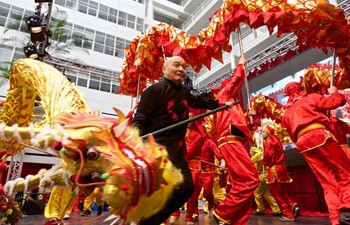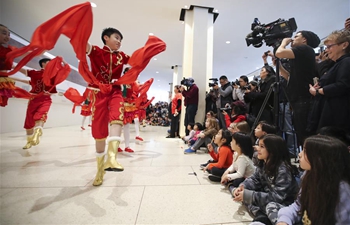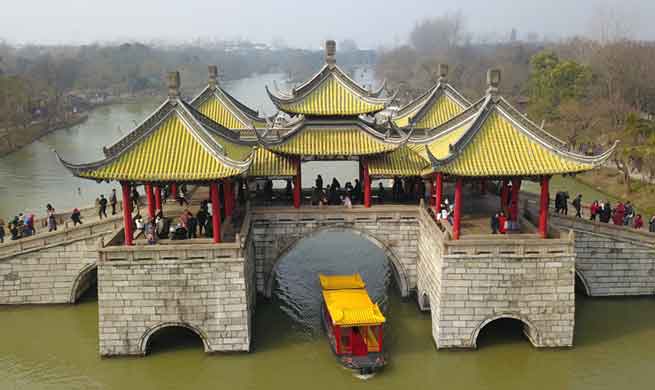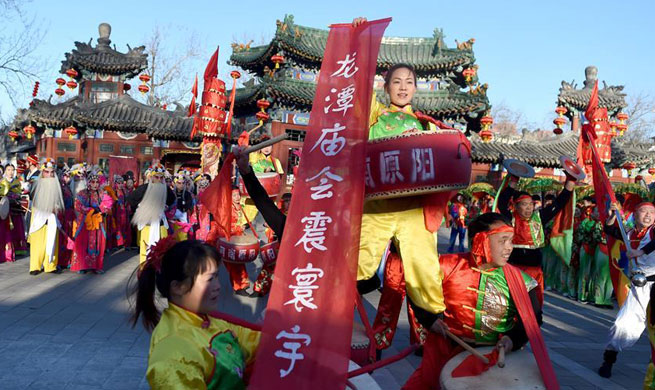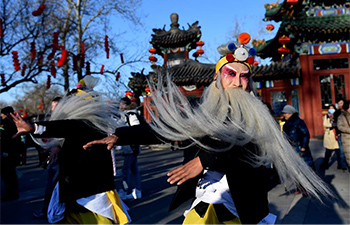WUHAN, Feb. 18 (Xinhua) -- Zhou Yiqiao, a veteran bridge engineer, was happy to see a new bridge over the Yangtze River open to traffic in the central city of Wuhan in late December.
The Zhuankou Yangtze River Bridge, 8.6-km-long and 46-meters-wide, is the widest bridge over the Yangtze River.
Zhou's given name Yiqiao, literally meaning "the first bridge" in Chinese, was given by his grandfather in memory of the start of construction of the Wuhan Yangtze River Bridge in 1955, the first bridge across the Yangtze that runs from the plateau region in the west to Shanghai in the east for about 6,300 km.
"My grandparents often took me to the construction site when I was a child," Zhou Yiqiao said.
Zhou's father designed one of the eight piers of the bridge, which was operational in 1957.
"It started at a time when the People's Republic of China was just established and bridge construction technologies mainly relied on Russian expertise," Zhou Yiqiao said. "My father and his colleagues worked in really hard conditions to complete the project."
Zhou's father then joined the building of Nanjing Yangtze River Bridge, the first heavy bridge designed and built using Chinese expertise.
Following his father's footsteps, Zhou studied bridge engineering in college and became a bridge designer.
Zhou Yiqiao said he had witnessed tremendous progress in China's bridge building technology over the years.
Currently, Wuhan has nine Yangtze bridges open to traffic. Every day more than 700,000 vehicles cross the river using these bridges, greatly easing the city's traffic.
There are 135 bridges across the main stream of the Yangtze, about 30 of which are under construction, according to Liu Ziming, chairman of the China Railway Major Bridge Engineering Group (CRMBEG).
"Nowadays, we play a leading role in setting international standards for bridge design and building in the world," said Mao Weiqi, CRMBEG deputy chief engineer.
The major Chinese bridge builder has built more than 2,000 bridges worldwide, with a total length of over 2,000 kilometers, equal to a round trip distance between Shanghai and Beijing, according to Mao.
Padma Bridge, which will be the longest bridge in Bangladesh, is being built by the group. Expected to be completed in 2018, the bridge will link the southwestern part of the country to northern and eastern regions.
"Our bridge building technologies have gone abroad and these bridges are connecting us with the world," Zhou said.
For Simon Haworth, a British entrepreneur, he and his family are also building a "bridge" connecting China with the rest of the world.
Haworth set up the Dynasty Biotechnology Company in a bio-industry park in Wuhan in 2012.
In the 1870s, his great-great-grandfather Henry Haworth established a silk trading company in Shanghai. In 1887, Henry sent his first son Harry to learn business there.
In the 1960s, Simon's grandparents visited China twice. His grandmother kept a diary which recorded their experiences.
"One of the most important trips they had was in Wuhan. They were taken to the first bridge over the river, " Haworth said. "In my grandma's diary, she talked about how proud people were of the bridge."
Just like his great-great grandfather, Haworth has also sent his eldest son, George, to Shanghai, for an internship. He calls it another "echo of history," - two fathers doing the same thing for a similar purpose, and born of the same optimism about China.
When Haworth came to Wuhan for the first time, the city had seven bridges over the Yangtze.
"In recent years, the city's infrastructure such as the newly built Yangtze bridge, the high-tech industrial park and high-speed railways, have been well improved," he said.
In 2016, China released a guideline build the "Yangtze River Economic Belt" that aims to create a new economic engine for China, with core roles for Shanghai, Wuhan and Chongqing.
In 2016, Wuhan utilized more than 8.5 billion U.S. dollars of foreign capital, up 16.1 percent year on year.
"After the release of the guideline, we are confident that foreign investment will have a better development prospect," Haworth said. "Now we have more opportunities to use Wuhan as a bridge and a hub to bring bio, clean and agricultural technology businesses from Europe and the U.S. to China."
Haworth's company is also involved in cultural exchanges between China and Britain. The project, run by Dynasty Youth Exchange, sends Chinese teenagers to the UK and vice versa for both to experience different cultures and promote communication between the two countries.
"I want to do some work to sweep aside misunderstandings and prejudice between China and the UK," he said. "I think it is like a bridge I am building between China and the world. My task is to use the exchange of sciences and culture to build the bridge connecting Wuhan, China and the outside world."





